Related Research Articles

Kyrgyzstan or the Kyrgyz Republic is a landlocked country in Central Asia. Kyrgyzstan is bordered by Kazakhstan to the north, Uzbekistan to the west, Tajikistan to the south, and the People's Republic of China to the east. Its capital and largest city is Bishkek.

The Islamic Movement of Uzbekistan was a militant Islamist group formed in 1998 by Islamic ideologue Tahir Yuldashev and former Soviet paratrooper Juma Namangani; both ethnic Uzbeks from the Fergana Valley. Its original objective was to overthrow President Islam Karimov of Uzbekistan and create an Islamic state under Sharia; however, in subsequent years, it reinvented itself as an ally of Al-Qaeda. The group also maintained relations with Afghan Taliban in 1990s. However, later on, relations between the Afghan Taliban and the IMU started declining.

The vast majority of people in Kyrgyzstan are Muslims; as of 2020, 90% of the country's population were followers of Islam. Muslims in Kyrgyzstan are generally of the Sunni branch, mostly of the Hanafi school, which entered the region during the eighth century. Most Kyrgyz Muslims practice their religion in a specific way influenced by shamanic tribal customs. There has been a revival of Islamic practices since independence in Kyrgyzstan. For the most part religious leaders deal only with issues of religion and do not reach out to communities, but rather offer services to those who come to the mosque. There are regional differences, with the southern part of the country being more religious. Kyrgyzstan remained a secular state after the fall of communism, which had only superficial influence on religious practice when Kyrgyzstan was a Soviet republic, despite the policy of state atheism. Most of the Russian population of Kyrgyzstan is Russian Orthodox. The Uzbeks, who make up 14.9 percent of the population, are generally Sunni Muslims.

Osh is the second-largest city in Kyrgyzstan, located in the Fergana Valley in the south of the country and often referred to as the "capital of the south". It is the oldest city in the country and has served as the administrative center of Osh Region since 1939. The city has an ethnically mixed population of 322,164 in 2021, comprising Kyrgyz, Uzbeks, Ukrainians, Koreans, and other smaller ethnic groups. It is about 5 km from the Kyrgyzstan-Uzbekistan border.
The Tulip Revolution or First Kyrgyz Revolution led to President of Kyrgyzstan Askar Akayev's fall from power. The revolution began after parliamentary elections on February 27 and March 13, 2005. The revolutionaries alleged corruption and authoritarianism by Akayev, his family and supporters. Akayev fled to Kazakhstan and then to Russia. On April 4, 2005, at the Kyrgyz embassy in Moscow, Akayev signed his resignation statement in the presence of a Kyrgyz parliamentary delegation. The resignation was ratified by the Kyrgyz interim parliament on April 11, 2005.
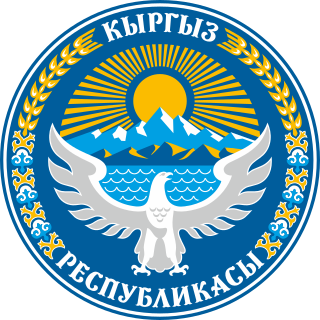
Human rights in Kyrgyzstan improved after the ouster of President Askar Akayev in the 2005 Tulip Revolution and the installment of a more democratic government under Roza Otunbayeva. While the country is performing well compared to other states in Central Asia, many human rights violations still take place. While LGBT rights have been declining in recent years, freedom of press has been improving.
Terrorism in Tajikistan stems largely from the forces of the political opposition who opposed the comprehensive peace agreement that ended the civil war in 1997. President Emomali Rahmonov and UTO leader Said Abdullah Nuri signed the agreement on 27 June, believing it would bring an end to hostilities. However, dissident Islamist militants led by Tohir Yo‘ldosh and Juma Namangani formed the Islamic Movement of Uzbekistan in 1998, allying with Al-Qaeda and vowing to unite Central Asia as an Islamic state. The latest terror attacks took place in the Qabodiyon District on November 6, 2019, when a policeman and a border guard were killed by several Islamic State militants. 15 terroristi were also killed.
Terrorism in Kyrgyzstan has increased since the U.S. military invaded Afghanistan and overthrew the Taliban in 2001. The governments of Kyrgyzstan and Uzbekistan provided airbases for counter-terrorism operations. Southern Kyrgyzstan is increasingly sympathetic to terrorism and Islamic extremism.
The threat of terrorism in Kazakhstan plays an increasingly important role in relations with the United States which in 2006 were at an all-time high. Kazakhstan has taken Uzbekistan's place as the favored partner in Central Asia for both Russia and the United States. Kazakhstan's counter-terrorism efforts resulted in the country's 94th ranking among 130 countries in the 2016 Global Terrorism Index published by the Institute of Economics and Peace. The higher the position on the ranking is, the bigger the impact of terrorism in the country. Kazakhstan's 94th place puts it in a group of countries with the lowest impact of terrorism.
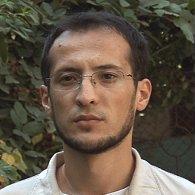
Alisher Saipov was a Kyrgyzstani journalist of Uzbek ethnic origin and editor-in-chief of the newspaper Siyosat of the country's ethnic Uzbek minority, which reported on human rights abuses in neighboring Uzbekistan. Saipov often wrote articles critical of Uzbek President Islam Karimov and his government. He wrote extensively about torture in Uzbek prisons, the clampdown on dissent, and the rise of Islamic radicalism. He also worked as a correspondent for RFE/RL and Voice of America. He was shot dead at close range outside his downtown office in Osh in October 2007.
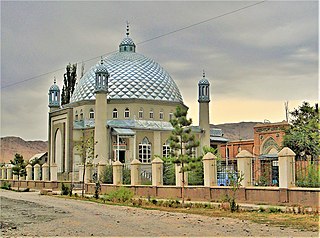
Islam is the main religion in Kyrgyzstan and the constitution guarantees freedom of religion. Kyrgyzstan is a multicultural and multi religious country with Islam, Buddhism, Baháʼí, Christianity, Judaism, and other religions all having a presence in the country. Muslims constitute the main religious group in Kyrgyzstan with about 90% of the population as of 2017.
The Constitution provides for freedom of religion and for the principle of separation of church and state; however, the Government continued to restrict these rights in practice. The Government permits the operation of what it considers mainstream religious groups, including approved Muslim groups, Jewish groups, the Russian Orthodox Church, and various other Christian denominations, such as Roman Catholics, Lutherans, and Baptists. Uzbek society generally tolerates Christian churches as long as they do not attempt to win converts among ethnic Uzbeks; the law prohibits or severely restricts activities such as proselytizing, importing and disseminating religious literature, and offering private religious instruction.
Jumaboi Ahmadjonovich Khodjiyev, better known by the nom de guerreJuma Namangani, was an Uzbek Islamist militant with a substantial following who co-founded and led the Islamic Movement of Uzbekistan (IMU) with Tohir Yo'ldosh. The IMU received substantial Taliban patronage, and was allowed to operate freely in northern Afghanistan.
Rafik is the given name of:
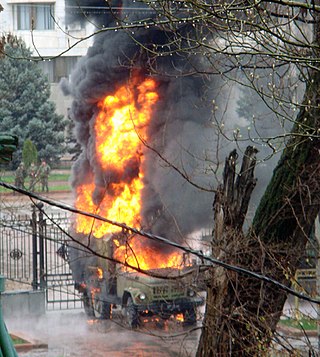
The Kyrgyz Revolution of 2010, also known as the Second Kyrgyz Revolution, the Melon Revolution, the April Events or officially as the People's April Revolution, began in April 2010 with the ousting of Kyrgyz president Kurmanbek Bakiyev in the capital Bishkek. It was followed by increased ethnic tension involving Kyrgyz people and Uzbeks in the south of the country, which escalated in June 2010. The violence ultimately led to the consolidation of a new parliamentary system in Kyrgyzstan.
The 2010 South Kyrgyzstan ethnic clashes were clashes between ethnic Kyrgyz and Uzbeks in southern Kyrgyzstan, primarily in the cities of Osh and Jalal-Abad, in the aftermath of the ouster of former President Kurmanbek Bakiyev on 7 April. It is part of the larger Kyrgyz Revolution of 2010. Violence that started between Kyrgyz and Uzbeks on 19 May in Jalal-Abad escalated on 10 June in Osh.
On 13 May 2005, protests erupted in Andijan, Uzbekistan. At one point, troops from the Uzbek National Security Service (SNB) fired into a crowd of protesters. Estimates of those killed on 13 May range from 187, the official count of the government, to several hundred. A defector from the SNB alleged that 1,500 were killed. The bodies of many of those who died were allegedly hidden in mass graves following the massacre.

Gadzhimurat Magomedovich Kamalov, was a Russian investigative journalist and the owner of Svoboda Slova, the media company that published the newspaper Chernovik.
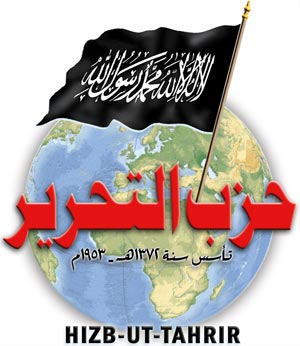
Hizb ut-Tahrir is a pan-Islamist and fundamentalist group seeking to re-establish "the Islamic Khilafah (Caliphate)" as an Islamic "superstate" where Muslim-majority countries are unified and ruled under Islamic Shariah law, and which eventually expands globally to include non-Muslim states. In Central Asia, the party has expanded since the breakup of the Soviet Union in the early 1990s from a small group to "one of the most powerful organizations" operating in Central Asia. The region itself has been called "the primary battleground" for the party. Uzbekistan is "the hub" of Hizb ut-Tahrir's activities in Central Asia, while its "headquarters" is now reportedly in Kyrgyzstan.

Ahmadiyya is an Islamic community in Kyrgyzstan, whose teachings were first brought into the country by foreign Pakistani missionaries in the early 1990s. Although the Community was first registered in the country in 2002, its registration was struck off with the country's State Commission on Religious Affairs refusing to re-register it in 2011. Today, the Community which faces religious persecution, represents up to 1000 members spread across the capital Bishkek and three other regions of the country.
References
- ↑ "Popular Kyrgyz imam shot dead". 2006-08-07. Retrieved 2022-12-31.
- ↑ House, Freedom (2005). Freedom in the World 2005: The Annual Survey of Political Rights and Civil Liberties. Rowman & Littlefield. p. 355. ISBN 978-0-7425-5051-3.